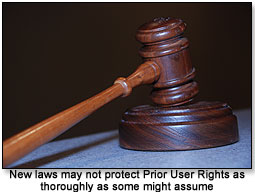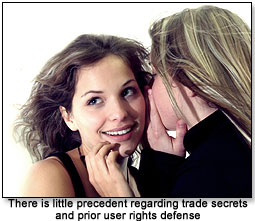 |

Tools:








Requirements and Caveats of the AIA's "Prior User Rights"Think the AIA’s Expansion of “Prior User Rights” Will Help your Patent Dispute? Think Again.
 The October 2011 issue of TDmonthly included an overview of the America Invents Act (AIA) patent legislation. Many of the AIA provisions will be phased in over the next fifteen months, and implementation details are currently under study to make the transitions go as smoothly as possible. One AIA provision already in effect expands the patent infringement defense known as “prior user rights.” This article provides more information on the scope of the prior user rights defense and caveats on its use. (For the full text of the prior user defense, see http://www.uspto.gov/aia_implementation/20110916-pub-l112-29.pdf at page 297. ) The October 2011 issue of TDmonthly included an overview of the America Invents Act (AIA) patent legislation. Many of the AIA provisions will be phased in over the next fifteen months, and implementation details are currently under study to make the transitions go as smoothly as possible. One AIA provision already in effect expands the patent infringement defense known as “prior user rights.” This article provides more information on the scope of the prior user rights defense and caveats on its use. (For the full text of the prior user defense, see http://www.uspto.gov/aia_implementation/20110916-pub-l112-29.pdf at page 297. )
Expanded Defense
To recap, under the AIA, if a potential infringer commercially used a process or a composition, manufacture or machine used in a manufacturing or commercial process at least one year prior to the effective filing date of a patent, then that potential infringer has the defense of prior user rights. (In situations where the patent holder disclosed the invention prior to patent filing but filed the patent application within his one-year grace period for U.S. patent filing, the prior user must establish the prior commercial use at least one year prior to the patentee’s public disclosure. )
This expanded defense applies for all patents issued on or after September 16, 2011. The prior user shares some of the benefit of early use of the invention, but without incurring the expense of the patent. This protects entities who may have conceived of and also commercially used an invention early, but for various reasons did not pursue a patent. It is, in effect, protection against a patent holder for those who kept their prior inventions a trade secret. The prior user, however, ultimately does not hold any patent rights or other rights of exclusion himself.
 Trade Secrets Trade Secrets
Trade secret is a widely-used form of intellectual property, and the expanded prior user right may at least appear to enhance its viability. However, prior user rights have very little track record in U.S. patent law. Even before AIA, prior user rights did exist in in a more limited form. In a 1999 incarnation of the U.S. patent law, prior user rights were only afforded to “method” patents and more particularly, “business method” patents. However, in its 12 years of existence, there has only been one significant reported case that dealt with prior user rights in any detail. In that case, the Federal District Court for the Southern District of Iowa denied the application of prior user rights for general commercial applications and drew the boundaries of prior user rights very narrowly. Other courts, including the Northern District of California, also suggested that it would construe the subject matter of prior user rights narrowly.
Prior User Defense = Conceding to Patent Infringement?
With this background, one must remain aware that while the AIA expands the boundaries of prior user rights to virtually all statutory classes of inventions (such as processes, apparatus, compositions and subjects of manufacture) beyond the narrow “method” class, this concept remains largely without any precedent in the United States. Thus, it is not clear how closely a prior user’s apparatus, device or machine must match with the patent claim before the prior user right will attach. A prior user essentially concedes patent infringement to raise this prior user defense. This does not foreclose other forms of patent infringement defenses but it does cast an alleged infringer in a rather untenable position, leaving less room for maneuvering or negotiation. In addition, the prior user defense must also be proved with a high level of proof amounting to clear and convincing evidence. At least one legislator commented in drafting the 1999 version of prior user rights that the better defense against patent infringement is a viable assertion of patent invalidity based on other statutory grounds such as lack of novelty or obviousness of the patented invention.
A Non-Transferable Defense
In this regard, the prior user defense does not create any invalidating prior art against a third party’s patent. While the holder of a purported prior user right may be able to create a personal safe harbor for his own activities, the same acts of prior use to attack the validity of the patent are not effective at all if kept secret. Similarly, the prior user may not assign, license or transfer this personal “safe harbor” to a third party, except as an ancillary and subordinate part of a good faith transfer of an enterprise or line of business.
This means that a toy or game designer who conceives of a product and contemplates selling rights to make or use a toy design to a third parties for manufacturing or distribution purposes cannot convey the defense of prior user rights. The conception alone is likely not enough to trigger a prior “user” right. Moreover, the AIA includes limitations on the manufacturing sites where prior user rights attach. Given these constraints, the toy designer would be better off securing a patent which affords a right to exclusivity and which also enjoys a presumption of validity once the patent issues. Moreover, the patent right can be assigned freely without the constraints of assigning an entire business line as would be required for the ancillary “transfer” of a prior user defense.
 Keep Meticulous Records Keep Meticulous Records
Despite the pitfalls and unknowns of the expanded prior user right as discussed above, if one hopes to invoke a prior user right prior against a patent holder, certain steps should be taken to create and maintain careful records. First, documentation should be kept on dates that such items of manufacture, machines and apparatus were created. These records should also include details on the operation of the machine, apparatus or manufacture. The records also need to reflect the commercial nature of the use of the subject matter, such as their use to manufacture articles for sale and documentation of arms-length transactions of such sales. Wherever possible, the documentation should be corroborated or witnessed to assist in meeting the clear and convincing standard.
In many ways, AIA aligns the U.S. laws with other national patent laws around the world. Congress requested studies on the impacts of AIA on small business and comparison of the U.S. laws with foreign patent laws. The U.S.P.T.O. has already solicited commentary on the prior user rights provisions of AIA, which will be formally reported in mid-January 2012. The U.S.P.T.O. has currently compiled comments on AIA from various intellectual property and trade organizations for review at www.uspto.gov/aia_implementation/prior-user-rights-comments.jsp.
 Writer's Bio: Writer's Bio: Susan Perng Pan is partner in the Washington, D.C., office of the global intellectual property firm, Sughrue Mion PLLC. She litigates multi-party complex patent disputes before several U.S. federal district courts, the U.S. International Trade Commission, and the U.S. Federal Trade Commission. Her practice also includes preparing and prosecuting patent applications, appeals and interferences before the U.S. Patent and Trademark Office. She may be contacted at span (at) sughrue.com. Read more articles by this author
THIS BANNER IS AN AD:

• • • • • • • • • • • • • • • | • • • • • • • • • • • • • • |
Back to TDmonthly's front page
|  |
Advertise on TDmonthly

|

